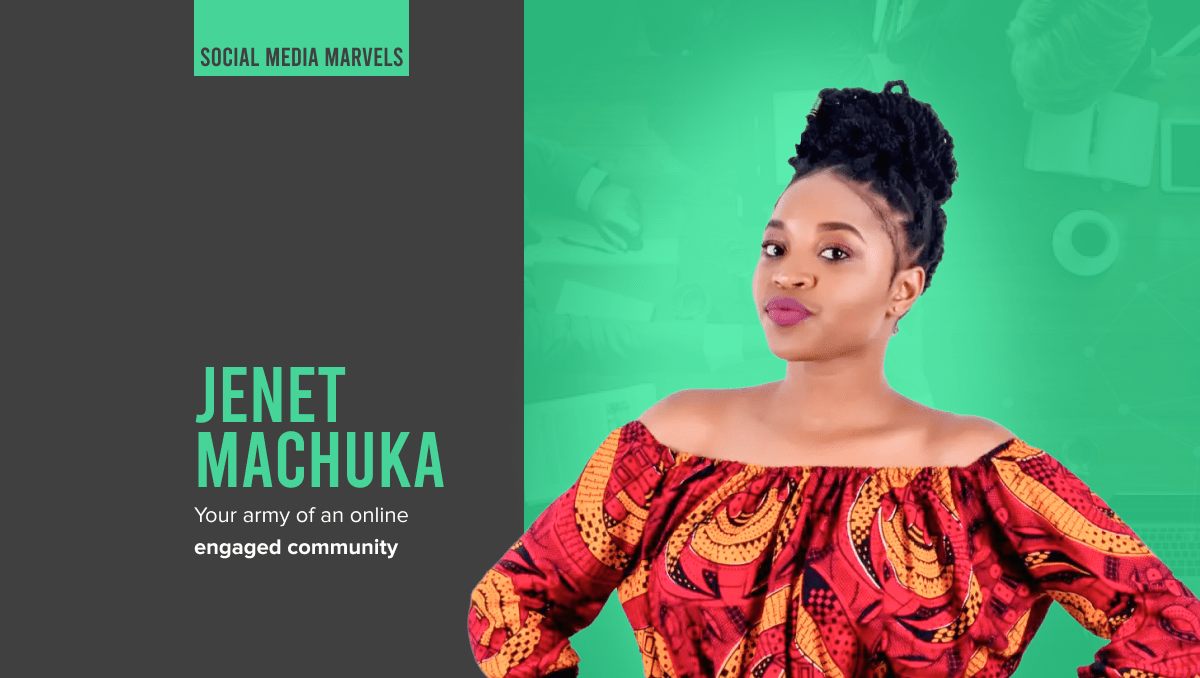The Social Media Marvels continues the conversation on building online communities with Janet Machuka. In this part, we dig deeper about the strategies a company must use to increase engagement, leveraging community members to build branding, and of course how does a brand deal with negative comments.
Find the summarized
What Do I Expect from this video :
- How can communities and engagement help you deal with negative comments.
- Automated messages or personalization – which way should I go?
- Accountability for the comments posted within the community.
- When are you as an influencer or a community member heard by the brand/other members of the community?
- Actionable tips for brand building via a strong community.
Q – User-generated content is appreciated not only by the people but by Google as well. But there are cases in terms of reviews, that a user might drop a negative review. Now, you really can’t advertise it or you can’t really say that, “Oh one of the customers have also said this.” And how do you make it into a positive feedback and portray it to other members of the community as well?
A -When a user or a potential customer leaves a negative, which truly points out the gap of your product, it is always advisable to acknowledge it. You might not have to do it openly on a public forum. But you can steer the conversation on a more personal platform – a DM or an email.
Once you acknowledge your mistake, a user feels that the brand paying attention. This adds to the social value of the company. Once, you’ve incorporated the changes – these naysayers become your biggest brand appreciators.
Jagruti – And also when you try and convert a negative review into a positive, that is much more noticeable because they’re more loyal. Because then they understand that yes, this brand, this company does value growth, does value that it can not always be right. So, yeah.
A -Exactly. The whole idea is to listen to your audience. It shouldn’t always be about ‘me,me,me”. When you respond to a negative comment, the attention alone serves as a positive view in the eyes of the user.
There are two scenarios where a brand brews negativity. One, instead of communicating, you ignore the suggestions or the negative comments given by the users. This throws you, as a brand, under a bad light. Two, when you have an automated response towards any comments. This shows that the brand is not ready to engage one-on-one, but rather wants to mechanize the responses.
As a piece of advice to community managers and pages handling brand communication – do not invest in an auto-responder. Engage with your audience on a personalized level. Generic or auto responses further enrage and not pacify our users.
Personalized communication via DMs should be one of the key factors in building a stronger brand affinity in 2020.
Jagruti – That is so true. I mean and also dealing with negativity and focusing on personally replying to them. I was just thinking that a lot of Facebook groups or communities, they are moderated, but they’re not that closely moderated. So then you can’t really always keep a tab on what people are saying about maybe another member of the community or are they only blindly promoting themselves or something like that. So how do you sort of manage that, because you can’t really closely moderate it because it’s social media and there are no legal laws per se.
A -It is very difficult to control the content being shared or the tone of it via our audience. One sort of control could be ensuring the group contents are private and accessible only by approved members.
Despite certain restrictions in place, some members still manage to share content which is either inappropriate or irrelevant. Members, that come to learn, find this as a disturbance. There are also times at which, members use messages that are highly negative.
I encountered this problem while I was conducting Africa TweetChats. Instead of immediately responding, I used to take up the conversation to the DMs. By the end of the conversation, the member is nurtured towards being an active and positive contributor to the community.
It is always safe to approach negative users with a calm mind. If we try and force our opinions, they tend to feel attacked and then the negativity spreads across platforms and communities. This ends up tarnishing the name of your brand itself.
Jagruti – Yeah, but like you say, you being a part of the brand or maybe you might be one of the really elite members of the community. You might be a big influencer. When you approach these people, they actually listen to you. They’re like, “Okay, I might agree with you.”
Jagruti – But what if there are normal people who really are passionate about the brand or the community, and they try and speak out, but so then it’s just a war, because then they’re normal people so the content that they share or the opinions that they share don’t hold that much value such as yours or a brand speaking up for itself. So how does a business … Because of the genuineness or the credibility factor that somebody’s sharing or talking about you, is important for a brand. So only if big influencers or paid sponsorship or the brand itself, employees itself are talking about you, then the audience might not feel the content is genuine.
But when smaller members or people who are using the products since a long time, they speak about it. It might not create a lot of impact, but it does engage with one or two people, if not in a big-
Q – How do non-influencers/normal people passionate about our brand/content, build credibility through engaging with other members of the group?
A -When it comes to social media and brands utilizing its power, they can leverage either big influencers or even micro-influencers. It all depends on strategy – either work with big influencers, pay them heftily, get generic content/sponsorships; or work with smaller influencers that are more invested, both with the brand and their audience.
Brands, these days, don’t stop at collaborating with just influencers. They also collaborate with communities, niche groups, chats, etc. The avenue depends on strategy and research conducted via their conducting team.
It’s a collaborative effort between writers, community managers, analysts – to recognize which of the above could lead towards making the right messaging reach a wider audience.
The brand has to decide between why are they choosing a particular avenue? Is it purely based on follower count or other factors like content, engagement, credibility are also put into consideration.
Besides choosing the avenue, brands also need to consider their objective – is it driving traffic or getting more engagement or generating those big sales numbers? Is employee advocacy a part of their social media culture? Is this a one time strategy or a longer-term collaboration?
If it’s a one-time effort, then the results won’t be great. It has to become a part of the workflow. Brands need to learn, unlearn, and relearn from the efforts put across various resources.
And one other thing, if a brand outsources the community efforts to an agency – you need to strategize and educate yourself first! If an agency makes tall promises and doesn’t deliver, the brand can’t keep switching between agencies till they find the right one. Also, choosing agencies to work for them to achieve a particular goal and moving on to the next one, since a change in strategy, won’t work in the long term.
When it comes to building communities, relations with influencers, and employees – collaboration is the key. Long-term collaboration.
Q – If we do have a highly engaged community, seasoned influencers, speaking about our brand – would paid campaigns still be a necessity or worthy?
A -It depends. What is the objective of the brand? Are you running ads to gain traction for a particular event – a product launch, maybe or is it for branding/growth? For the former, ads are a good start.
For the latter, only pushing out sponsored content, no real engagement, other elements of the strategy mix not working in sync – the campaign won’t be fruitful. Let’s take Twitter, for example, if you see a sponsored hashtag, there are more chances you won’t click on it. It is just going to listing high on the trends. But if the same hashtag content is shared by other people, influencers, there is real engagement, then creating ads around it will fetch better results.
Make the content audience-centric. We are trying to invade someone’s online profile. Hence, we need to make it about them rather than us. This how most shared content gets higher engagement.
But also remember to be authentic. Don’t change the style of your content just to get more engagement. If you change too soon, the authenticity depreciates and that does not resonate well with the audience.
To sum up, focus on trending events, sponsorships all the same. But build those strategies around your content and SEO strategy. At the end of the day, your content and the engagement you garner is going to make or break your brand.
More words of wisdom from Janet…
Just something I wanted to add, on the building online communities. People don’t necessarily understand what is a community on social media, and most of them usually think, this community must have people in a group. People on Facebook group, people on a Facebook page, or people in a Twitter chat kind of aspect, or LinkedIn groups.
It starts from your account. Remember you’re looking at people following you, people engaging with you, you sharing with other people, about your content, about what you’re doing, depending on what you want to, but in businesses, you’re sharing information about your products, your services, how people talk about your brand.
Always look at it from the aspect, that is a community. And those friends you have, they are your community. How do you engage with each other? How do you benefit from each other? So if brands look at this from the aspect, starting from their own brand, their own account as the community they are building, they will be easy to sprout more. Because when you go out like, “Oh, I’m joining Twitter, chats, I’m joining Facebook chats.” It’s like whatever you’re going to share in that new group, or to your page, if it’s Facebook from the group to your page, you’re sharing it to your community.
So in return, this community might end up being part of the other community. So everything is related. So let people look. I look at a community not from the aspect of, “Oh, we have to be in chats.” No. You are individuals who have similar or related interests from that page of yours. So always focus on sharing your experiences. Amplify your business through your messages. Your people will refer you, those who you refer. Collect reviews from people. Share the testimonies of other people. Get a relationship with your community.
The #SocialMediaMarvels is a podcast series that invites digital marketing influencers from across the world to celebrate their journey and get a glimpse of their contributions to the field. Get actionable tips, learn directly from the practitioners, and imbibe it to help your business.


